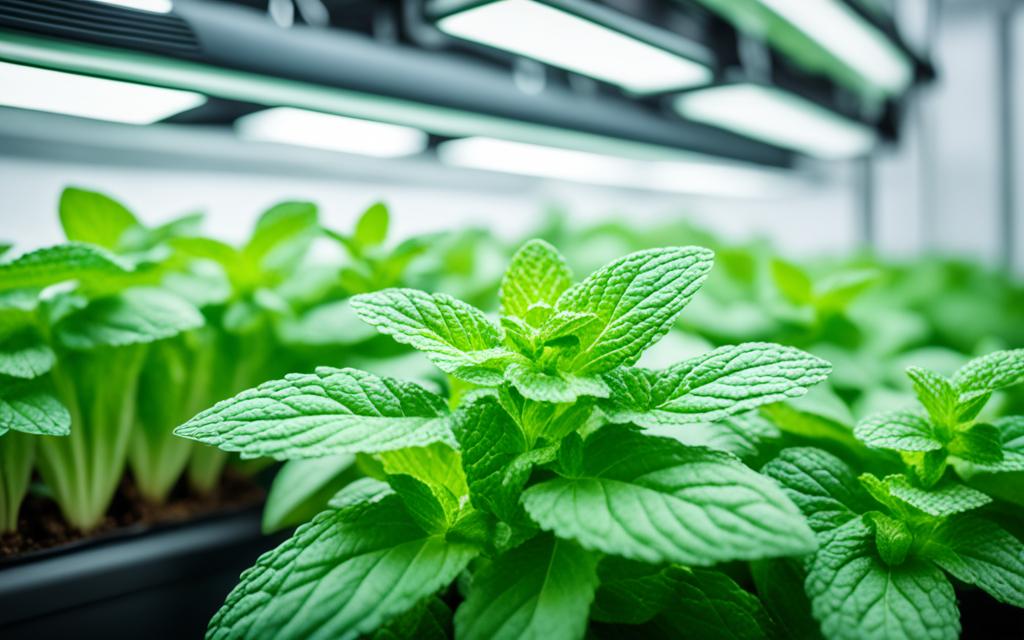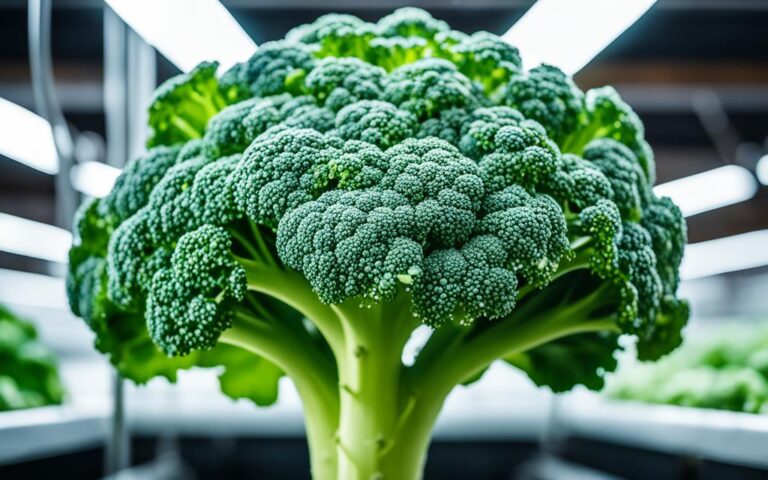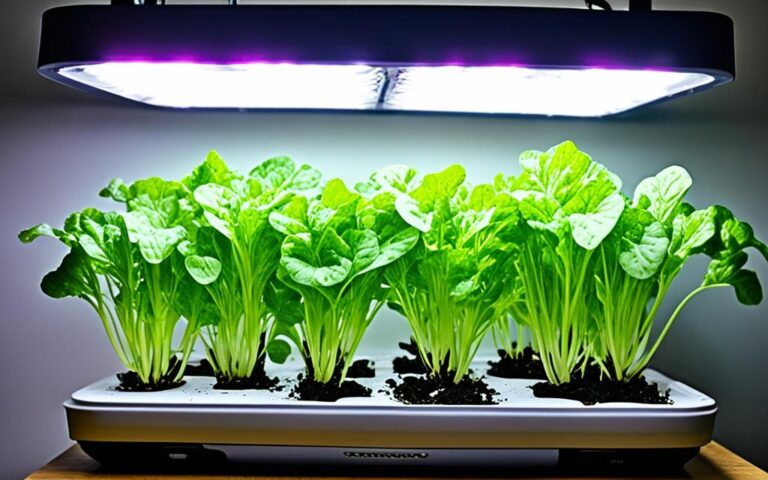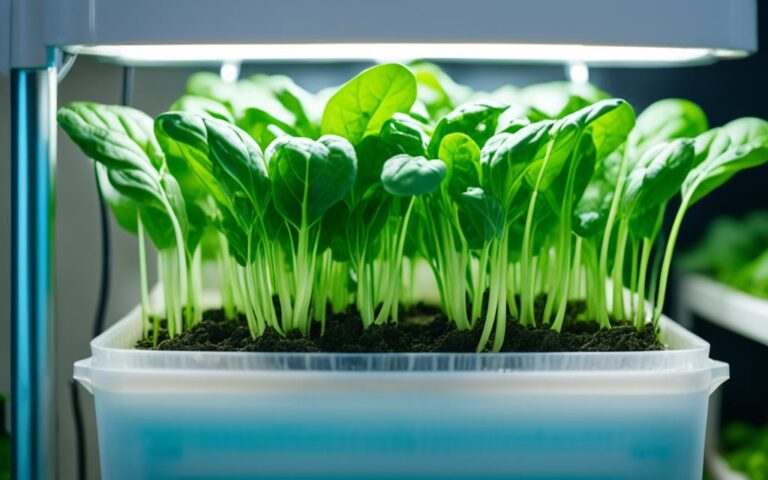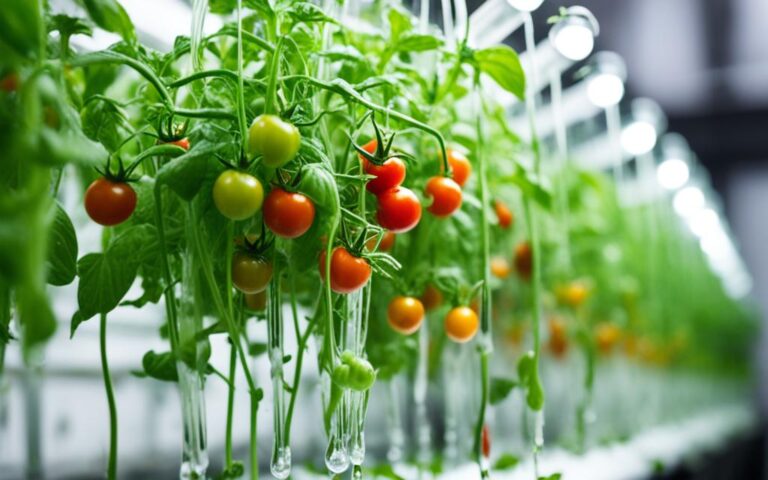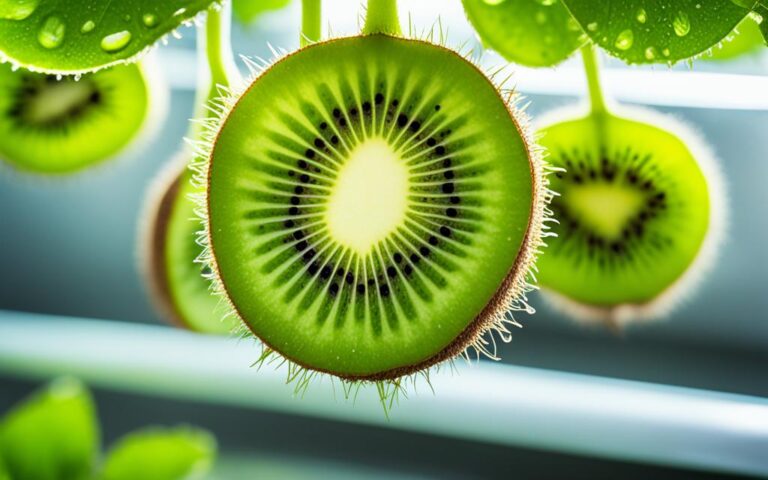Hydroponic Green Mint: Fresh, Sustainable Growth
Did you know hydroponic farming can produce up to 10 times more mint per square foot than traditional farming? This new way of growing is changing how we get our herbs. It offers a fresh, tasty, and green alternative to old farming methods.
Hydroponic green mint is leading the way in sustainable gardening and vertical farming. It grows mint in nutrient-rich water instead of soil. This means it uses less land, water, and pesticides. It’s a big win for those who care about the planet and want to grow their own food.
Key Takeaways
- Hydroponic farming can yield up to 10 times more mint per square foot compared to traditional soil-based methods.
- Hydroponic green mint is fresher, more flavorful, and better for the environment than conventionally grown mint.
- Hydroponic mint cultivation requires less water, land, and pesticides than traditional farming methods.
- Hydroponic systems allow for year-round mint production, making it accessible regardless of season.
- Hydroponic green mint represents a sustainable and innovative approach to urban gardening and vertical farming.
Table of Contents
Unlock the Potential of Hydroponic Green Mint
Mint is a versatile and aromatic herb that does well in hydroponic systems. It grows fast and spreads quickly, making it perfect for hydroponics. In a hydroponic setup, growers can control the water, nutrients, and conditions. This helps mint reach its full potential.
Why Mint Thrives in Hydroponic Systems
Several factors make mint great for hydroponics:
- Fast Growth – Mint grows faster in hydroponics than in soil. This is because it gets all the nutrients it needs and the conditions are perfect.
- Efficient Water Utilization – Hydroponics uses much less water than traditional gardening. This makes mint a good choice for those who want to save water.
- Year-Round Production – With hydroponics, mint can be grown all year. This means you always have fresh, fragrant leaves.
Benefits of Growing Mint Hydroponically
There are many advantages to growing mint hydroponically:
- Higher Yields – Hydroponic mint plants produce more than those grown in soil. This is because the growing conditions are better.
- Reduced Land and Water Usage – Hydroponics needs much less land and water than traditional gardening. It’s a good choice for city gardens or small spaces.
- Improved Flavor and Aroma – Hydroponic mint tastes and smells better. This is because it gets all the nutrients it needs and the conditions are just right.
“Hydroponic mint cultivation allows growers to harness the plant’s natural resilience and rapid growth, resulting in a bountiful, sustainable harvest year-round.”
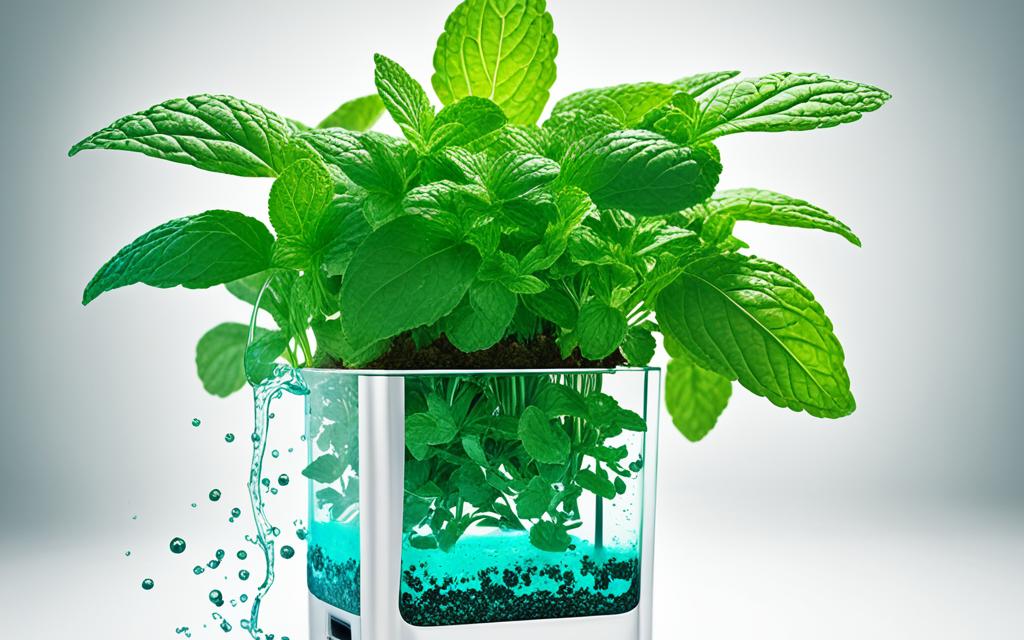
Selecting the Right Mint Variety
Choosing the right mint varieties for hydroponics is key. You want ones that grow well in a controlled setting. The best mint varieties for hydroponics have traits like strong growth, tasty leaves, and resistance to diseases. These are important for growing mint indoors.
Popular Mint Varieties for Hydroponic Cultivation
Here are some top mint varieties for indoor growing:
- Spearmint (Mentha spicata): It has a refreshing, slightly sweet taste. Spearmint is a dependable choice for hydroponics.
- Peppermint (Mentha × piperita): This variety has a strong minty flavor. It’s valued for its health benefits and cooking uses.
- Apple Mint (Mentha suaveolens): It smells and tastes like apples. This mint adds a special flavor to hydroponic gardens.
- Chocolate Mint (Mentha × piperita ‘Chocolate’): This mint tastes like chocolate. It’s a favorite for gourmet recipes.
These types of mint for hydroponics do well in hydroponic systems. They need a steady supply of nutrients and consistent growing conditions.
“Picking the right mint variety is key for the best growth and quality in hydroponics. Each type has its own taste and growth habits. So, choose the one that meets your needs and growing conditions.”
Starting with Seeds vs. Cuttings
Starting your hydroponic mint garden can be done with seeds or cuttings. Each method has its own benefits. The choice depends on what you want and how you like to grow.
Using mint hydroponically from seeds brings genetic variety. Seeds let you try new mint types in your garden. This can make your harvest more diverse and tasty. But, growing from seeds takes longer before you can harvest.
Choosing propagating mint for hydroponics with cuttings is faster. Cuttings grow roots quickly and can be put straight into your hydroponic setup. This way, you can start picking mint leaves sooner.
“Mint cuttings root easily and can be directly placed into the hydroponic system, where they will quickly develop a strong root system.”
Deciding between hydroponic mint propagation techniques like seeds or cuttings depends on your goals. Think about how fast you want your plants to grow, how much variety you want, and your growing experience. This will help you pick the best way for your mint garden.
Setting Up Your Hydroponic System
Growing mint with hydroponics means setting up a system that meets the plant’s needs. There are many hydroponic setups perfect for mint, each with its own benefits.
Types of Hydroponic Systems for Mint
The nutrient film technique (NFT) uses a flow of nutrient-rich water over the roots. The ebb and flow system floods and drains the grow tray like the tides. Deep water culture dips the roots in a nutrient solution.
Essential Components for a Mint Hydroponic Setup
Choosing a hydroponic system means getting the right parts. You’ll need a grow tray, a medium like perlite or coco coir, a water reservoir, and a pump. Keeping these parts in good shape is key for healthy mint plants.
- Water reservoir
- Submersible pump
| Hydroponic System | Key Components | Advantages |
|---|---|---|
| Nutrient Film Technique (NFT) |
| Efficient water and nutrient delivery, low maintenance |
| Ebb and Flow |
| Mimics natural tidal conditions, good for beginners |
| Deep Water Culture |
| Simplified setup, excellent oxygenation for roots |
Choosing the right hydroponic system and parts makes a great environment for mint. With the right setup and care, you’ll enjoy a lot of fresh, tasty hydroponic mint.
Nutrient Management for Optimal Growth
Getting the best growth and taste from hydroponic mint needs the right nutrient balance. Essential nutrients like nitrogen, phosphorus, potassium, calcium, magnesium, and micronutrients are key. It’s important to keep an eye on the nutrient solution’s pH, EC, and TDS levels. This ensures the mint gets what it needs at every stage of its life.
Unlocking the Essential Nutrients for Hydroponic Mint
To grow healthy, tasty hydroponic mint, you need to give it these key nutrients:
- Nitrogen (N): Vital for leaf growth and plant strength.
- Phosphorus (P): Helps with root growth and flowering.
- Potassium (K): Boosts plant stress resistance and taste.
- Calcium (Ca): Makes cell walls strong and keeps plants healthy.
- Magnesium (Mg): Important for making chlorophyll and enzymes.
- Micronutrients: Includes iron, boron, manganese, copper, zinc, and molybdenum for various functions.
By watching and adjusting the nutrients for hydroponic mint, growers can make sure their plants grow well, smell great, and taste amazing.
Choosing the right fertilizer for hydroponic mint is key. It gives the plant the right mix of nutrients for growth and yield. Always follow the fertilizer instructions and tweak the nutrient solution as needed for the best results in growing hydroponic mint.
Light and Temperature Requirements
Cultivating hydroponic mint needs a balance of light and temperature. These herbs need at least 6-8 hours of direct sunlight daily. For those growing indoors, high-quality grow lights can help. They make sure your mint plants get the lighting requirements for hydroponic mint.
The temperature range for hydroponic mint should be kept between 65-75°F (18-24°C). This range is key for strong growth, bright color, and the best growing conditions for hydroponic mint. If the temperature goes outside this range, it can slow down the plant’s growth and lower the quality of the harvest.
“Maintaining the proper light and temperature levels is the key to unlocking the full potential of your hydroponic mint crop.”
By giving your mint plants the right lighting and temperature, they will thrive. This ensures they produce a lot and taste great every season.
Hydroponic Green Mint: Fresh, Sustainable Growth
Hydroponic green mint has many benefits. It lets growers make high-quality herbs all year with less water, land, and pesticides. This is unlike traditional farming.
One big plus of hydroponic mint is the control it offers. Growers can set the perfect conditions for plants, like temperature and nutrients. This means better quality mint and less waste.
This controlled setting also makes the mint last longer and taste better. It’s a big win for those who love fresh mint.
| Benefits of Hydroponic Mint | Advantages of Growing Mint Hydroponically |
|---|---|
|
|
Hydroponic mint is also great for the planet. It uses less water, land, and pesticides. This makes it a key part of sustainable farming, perfect for city gardens and vertical farms.
“Hydroponic mint cultivation offers a fresh, sustainable solution to traditional mint growing, delivering consistent, high-quality herbs while minimizing the environmental impact.”
Water and pH Levels for Mint
For hydroponic mint to grow well, it needs the right water and pH levels. The ideal pH is between 6.0 and 7.0. This range helps the mint get the nutrients it needs for healthy growth and tasty leaves.
Monitoring and Adjusting pH Levels
Growers should check the pH in their hydroponic mint often and adjust it if needed. They use pH up or down solutions to keep the water just right. Keeping an eye on the pH in hydroponic mint is key for the plants’ health and how well they do.
Here are some tips for keeping the pH in hydroponic mint right:
- Check the pH levels of the nutrient solution at least once a week.
- Keep a record of the pH readings to identify any fluctuations or trends.
- Adjust the pH as needed, using small increments of pH up or pH down solutions.
- Avoid making drastic pH changes, as this can stress the mint plants.
- Ensure the ideal pH range for hydroponic mint is between 6.0 and 7.0.
By keeping a close eye on the hydroponic mint water requirements and pH levels, growers can make sure their mint plants do great. This leads to lots of tasty mint for harvest.
Pest and Disease Prevention
Growing mint hydroponically has many benefits, like fewer pests and diseases than soil-based methods. Yet, hydroponic mint growers must watch their plants closely for problems. Knowing about common pests and diseases helps in preventing and controlling them.
Common Pests in Hydroponic Mint
Some pests that can harm hydroponic mint include:
- Aphids: These small insects suck sap and can multiply fast, harming mint plants.
- Spider mites: These tiny arachnids eat the plant’s leaves, causing them to turn color and grow poorly.
- Thrips: These thin insects spread diseases and make mint leaves look distorted and change color.
Addressing Common Diseases in Hydroponic Mint
Hydroponic mint growers may face diseases, like:
- Root rot: This comes from fungi and can destroy the plant’s roots, killing it.
- Powdery mildew: A fungal disease that looks like white powder on leaves and stems, weakening the plant.
To prevent and control pests and diseases, hydroponic mint growers should keep growing conditions right, stay clean, and use pest management plans. Checking plants often, fixing problems fast, and using specific treatments can keep hydroponic mint healthy and thriving.
Harvesting and Storage Tips
Harvesting and proper storage are key to keeping hydroponic green mint fresh. Cut the stems just above the base, leaving a bit for more growth. Harvest in the morning for the best flavor and smell.
After cutting, store the mint in the fridge for up to two weeks or freeze it for longer. These steps help keep hydroponic mint fresh for a long time.
Tips for Storing Hydroponic Mint
- Keep harvested mint in the fridge, wrapped in a damp paper towel or in a resealable bag.
- Don’t store mint in water, as it can wilt and spoil.
- To store for a long time, freeze mint leaves in an airtight container or freezer bag.
- Freeze mint without thawing it first, making it easy to use in cooking and garnishing.
Follow these harvesting and storage tips to keep hydroponic mint fresh for weeks.
“The key to preserving the quality and aroma of hydroponic mint is to handle it with care and store it properly.”
Maximizing Yield and Flavor
Hydroponic mint growers can use different methods to boost their crops’ yield and taste. Pruning and training the plants are key to reaching this goal.
Pruning for Higher Yields
Pruning is vital for improving hydroponic mint yield. It means cutting off some stems and leaves to make the plant grow bushier. This way, the plant produces more leaves and stems, leading to more mint.
Training for Better Air Circulation and Light Exposure
Training mint plants also helps enhance the flavor of hydroponic mint. Using a trellis or vertical tower system improves air flow and light around the plants. This makes the plants more productive and boosts their oils, which give mint its smell and taste.
Pruning and training hydroponic mint are key for growers who want the best yield and flavor. These methods help growers get the most out of their mint plants. They ensure a high-quality, tasty product for customers.
Integrating Hydroponics into Urban Gardens
Growing hydroponic mint in cities is getting more popular. People want to grow fresh, sustainable herbs in small spaces. Hydroponic systems are great for this because they use space well. They’re perfect for small, indoor gardens in cities.
Hydroponic mint lets you have fresh herbs all year without needing a big garden. It’s great for city living because it uses less land and water than traditional gardens. This way, you can enjoy fresh mint at home.
Hydroponic mint is perfect for small outdoor spaces. You can put them on balconies, patios, or inside your home. This makes them great for growing hydroponic mint in urban settings.
“Hydroponic systems have changed how we grow herbs and veggies in the city. It’s a smart and green way to have fresh, tasty produce all year.”
Adding hydroponic mint for small spaces to your garden is a smart move. It lets you use hydroponics for indoor herb gardening. This method has many benefits for city living.
| Benefits of Integrating Hydroponic Mint into Urban Gardens | Challenges of Conventional Gardening in Urban Settings |
|---|---|
|
|
Conclusion
Hydroponic green mint is a fresh, sustainable way to grow high-quality herbs all year. It uses hydroponic systems for precise control over growing conditions. This means less waste and the ability to grow in small spaces.
This method is becoming more popular with home gardeners, urban farmers, and commercial producers. The demand for fresh, local produce is rising. Hydroponic mint meets this need while supporting sustainable farming.
The summary of hydroponic mint benefits and its future in cultivation show why it’s a smart choice. It’s perfect for those looking into urban horticulture and sustainable food production.
Hydroponic green mint is versatile, available all year, and good for the environment. It’s set to change modern agriculture. It will help meet the growing need for fresh, local herbs and spices.
